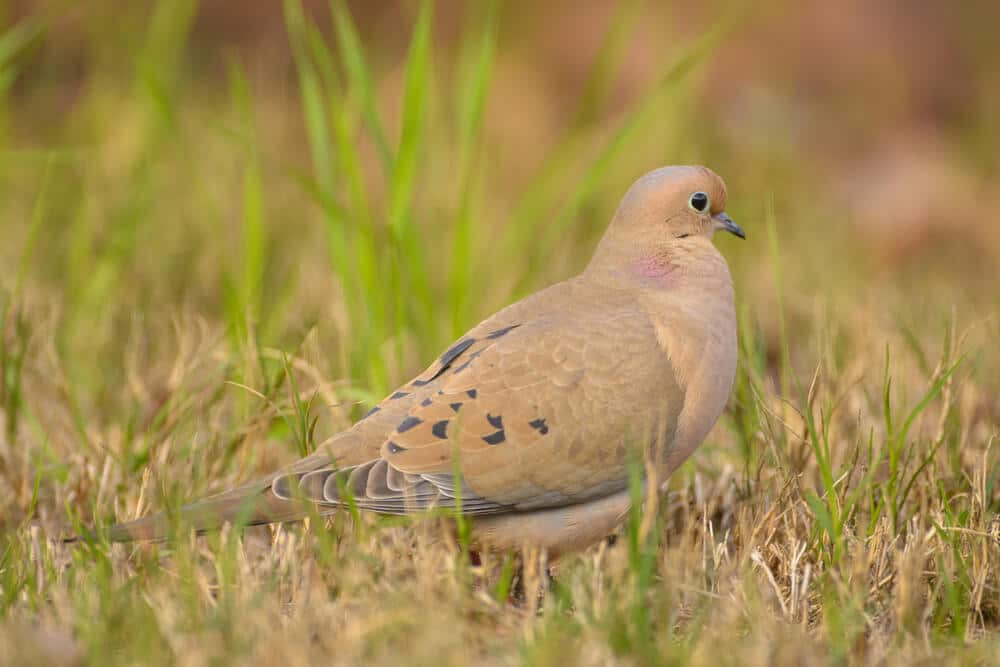From their speckled feathers to their unique cries that give them their name, mourning doves are fascinating creatures. If you live in North America, you have likely heard the cooing of a mourning dove or had the pleasure of seeing one visit your backyard bird feeder.
If you’ve had the opportunity to observe these elegant birds, you may have noticed their habit of “puffing up.” Mourning doves aren’t unique in this practice; many birds puff up their feathers for warmth in cooler temperatures or to make themselves look bigger if they feel threatened.
In this article, we’ll explore the behaviors of mourning doves and take a closer look at the reasons why a mourning dove might puff up its feathers.
Extending the Neck

Many can recognize mourning doves by their coloring. From a distance, mourning doves simply look light brown in color, but there is so much more to see up close!
Their backs are brown or grey with black spots on the wings and white-tipped tail feathers. Their underbellies are cream-colored with pink or purple spots.
However, mourning doves also have a unique shape, so much so that they can be recognized by their silhouette alone. These birds are about 12 inches tall and only weigh four to five ounces.
They have plump bodies, small heads and bills, short legs, and slender tails.
But you may not know that mourning doves often perch with their heads pulled close to their bodies, making it look like they have no neck.
However, when something catches their attention, the head will spring up from the body, revealing a thick neck and making the bird appear suddenly bigger. They will also extend the neck just before cooing.
This jack-in-the-box motion might be surprising if you’re not expecting it, but it’s perfectly normal behavior for a mourning dove. It’s just a natural change in posture.
Puffing Up Feathers for Warmth
Unlike many birds, mourning doves do not always migrate when the seasons change. Some mourning doves that reside in the northernmost parts of North America do head south for the winter, but many, especially those that live in more urban areas, will stay put during the colder months if there isn’t a shortage of food.
This means that mourning doves need to be equipped to handle colder temperatures. Feathers provide the bird’s body with insulation. Feathers are already designed to keep birds warm, but when they puff up their feathers, mourning doves create air pockets that trap their body heat close to their bodies while keeping cold air out.
Speaking of mourning doves, have you ever wondered about their intelligence? Read this fascinating guide to learn more: Are Mourning Doves Smart And Can They Recognize Humans?
Dealing with Predators
Mourning doves eat mostly grains like corn and wheat and occasionally insects. Because of this diet, they are ground feeders. In fact, even if they stumble upon a birdfeeder, mourning doves will often stay on the ground underneath the feeder, eating the seeds that other birds and animals have knocked to the ground.
Because mourning doves spend so much time on the ground, often out in the open in empty fields, they are exposed to predators of the ground and the sky. Common predators of the mourning dove include cats, dogs, raccoons, hawks, and owls.
When mourning doves feel threatened, they puff up their feathers to make themselves look bigger and hopefully scare off the predator or discourage it from attacking.
If you are concerned about the mourning doves visiting your bird feeder or bird bath, move it to an area that larger animals will have more difficulty getting to.
Aggressive Behavior
Mourning Doves can sometimes behave aggressively, particularly males. When he feels his nest or territory is threatened, a male mourning dove will chase off the offending bird or animal while hopping and puffing out his neck and feathers.
Young male mourning doves partake in this aggressive behavior more frequently than adults until they learn what qualifies as a threat.
Mating Season
Like most animals, mourning doves have specific behaviors during their mating season to attract mates. Males can become particularly aggressive during the mating season and will puff up their feathers to make themselves look bigger. This increased size helps them attract females and scare off rival males.
When a male mourning dove begins courting a female, he will fly near her, beating his wings loudly, before gliding in a circular pattern until it reaches the ground.
Then, he will approach the female with its feathers puffed up, cooing. Sometimes, you will even find two males chasing after a female, competing for her attention.
During the mating season, you can find male mourning doves with puffed-up feathers strutting around in front of females while cooing. Check out this video to see a close-up of a mourning dove’s mating call!
Food Aggression
Mourning doves can also become aggressive while feeding. These birds have big appetites and don’t take kindly to other animals encroaching on their food. They have even been known to chase other birds away from a bird feeder! They will puff up their feathers and aggressively chase the other birds until they give up and move along.
If you notice the mourning doves at your birdfeeder acting aggressively during feeding time, you can try a bigger feeder or multiple feeders to cut down on the need for competition.
Here’s a nice bird feeder that I highly recommend for mourning doves. It is big and spacious so there shouldn’t be any competition, and at the same time it perfectly suits their feeding style.
Stretching and Sunning
One of the mourning dove’s favorite activities is sunning themselves. These birds often take advantage of a sunny day and bask in the warm sunshine. When sunning, mourning doves are known to stretch out their wings and tail feathers to take in the rays. So, don’t be surprised to see a mourning dove spreading out its feathers on a bright, sunny day!
Final Thoughts
As you can see, there are several reasons you might see a mourning dove puffing up to make themselves look bigger. The mourning dove you’re observing might be keeping himself warm, trying to scare off a predator, or in the midst of courting a mate.
However, you shouldn’t forget that mourning doves are wild animals. You may enjoy watching them visit your bird feeder but don’t be tempted to get too close. Any animal that feels threatened could attack, and if the mourning dove that you’re watching is puffing up its feathers, it might consider you a threat!



